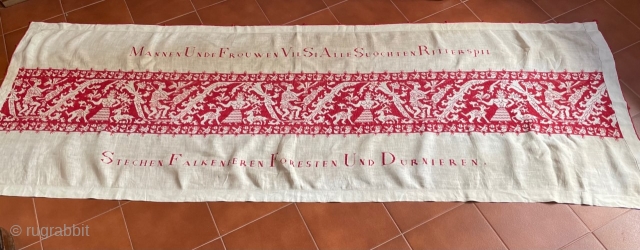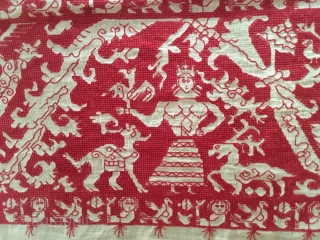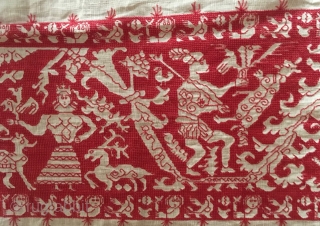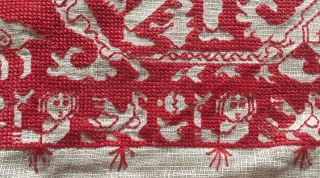Back
i am really not sure what this is and would be delighted with any suggestions. The panel comes from the Saxon area of Roumania and is embroidered on a thin rather open weave linen in small cross stitch and stem stitch. The edge is reinforced with a finer weave band and has a corded edging interspersed with little loops, perhaps meant for hanging. It is in very good condition and does not seem ever to have been used for whatever it was intended for.
The design suggests the figures of the mother goddess found at Knossos (Crete) in 1903 and this seems about the right date. Other elements include the affronted beasts and the huntsman or warrior associated with her. The little figures interspersed with birds along the borders call to mind the sirena, another very important element in the folklore of Crete and throughout the Greek archipelago. The text reads:
Mannen Unde Frouwen Vu Si Suochen Ritterspil
Stechen Falkenieren Foresten Und Durnkeren
Very roughly translated:
Men and women want to watch a knights’ contest. Jousting, flying falcons, fighting against each other in a forest.
Size 214cm/88" x 78cm/30"
price:
£350
- Home
- Antique Rugs by Region
- Category
- Profiles
- Post Items Free
- Albums
- Benaki Museum of Islamic Art
- Budapest: Ottoman Carpets
- Gulbenkian Museum
- Islamic Carpets. Brooklyn
- Islamic Textiles. Brooklyn
- Konya Museum: Rugs
- MKG, Hamburg
- MMA: Caucasian Carpets
- MMA: Mamluk Carpets
- MMA: Mughal Indian Carpets
- MMA: Ottoman Carpets
- MMA: Safavid Persian Carpets
- MMA: Turkmen Rugs
- McCoy Jones Kilims
- Ottoman textiles. Met
- Philadelphia Museum
- Rugs and Carpets: Berlin
- Seljuqs at the Met
- TIEM, Istanbul: Carpets
- V&A: Classical Carpets
- Vakiflar Carpets: Istanbul
- Baluch Rugs: Indianapolis
- Gallery Exhibitions
- Jaf an Exhibition
- Alberto Levi Gallery
- Andean Textile
- Christie's London: 2016
- Francesca Galloway
- HALI at 40
- ICOC Washington, DC 2018
- Jajims of the Shahsavan
- London Islamic Week April, 2018
- Mongolian Felts
- Navajo Rugs: JB Moore
- Persian Piled Weavings
- SF Tribal & Textile Art Show 2020
- SF Tribal 2019
- Sotheby's: C. Alexander
- Turkish Prayer Rugs
- Turkmen Main Carpets ICOC 2007












